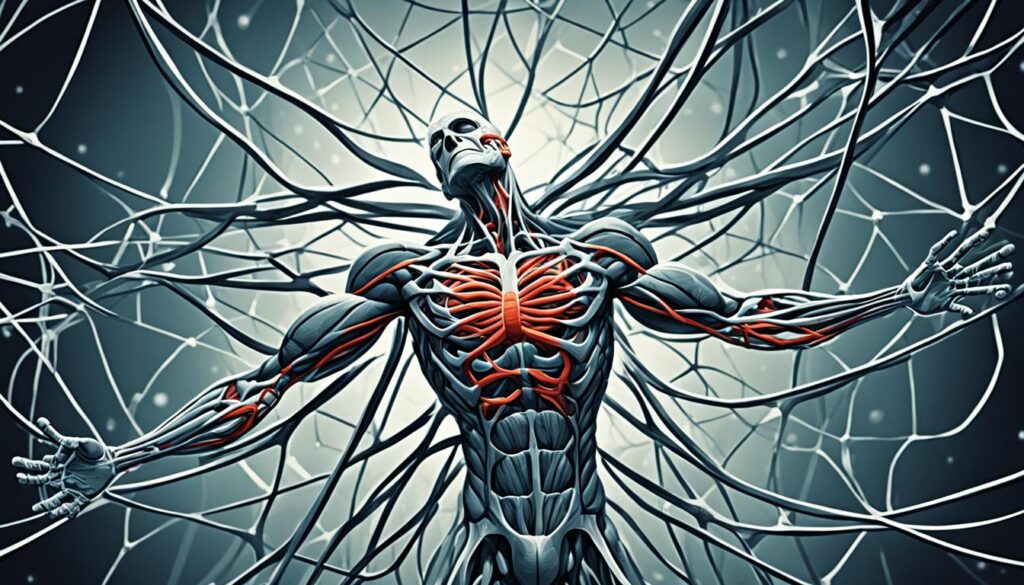Have you or someone you love been diagnosed with hereditary spastic paraplegia (HSP)? If so, you’re probably looking for answers. This condition is rare and passed down from family. It affects the legs, making them weak and stiff. It is known as familial spastic paraparesis. The cause is genetic, leading to damage in the spinal cord.
The effects of HSP can be very different from one person to another. Some feel only a little weak or stiff. Others get more disabled as time goes by. Doctors use exams and genetic tests to diagnose it. Right now, there’s no cure. But, treatments can help you live better.
Physical therapy, medicine, and devices can all help. Doctors will work with you to lessen the muscle problems. By knowing how to treat hereditary spastic paraplegia, you can play a big part in staying healthy and happy.
Table of Contents
ToggleWhat is Hereditary Spastic Paraplegia?
Hereditary Spastic Paraplegia (HSP) is a group of disorders you get from your parents. It mostly affects your legs, making them weak and stiff over time. It’s also called familial spastic paraparesis. This condition is about motor neurons in the spinal cord. They break down, making your leg muscles not work well.
Signs and Symptoms of Pure HSP
Most people with HSP, about 90%, have a less complex kind. Their main symptoms show up in their legs. They start with weak legs and muscles that are tight. It makes their muscles spasm. They might also have a hard time controlling their bladder. And they could miss feelings in their feet.
Signs and Symptoms of Complicated HSP
But about 10% of those with HSP face more symptoms. They might have nerve problems, epilepsy, or issues with their balance. Sometimes their eyesight, thinking, or skin might be different than usual. This more complex form is a bit harder to handle.
Progression of HSP Symptoms
HSP can act very differently from one person to another. For some, it doesn’t change much as they grow up. But for others, it gets a bit worse slowly over many years. The type of gene change you have can affect how bad the symptoms are and how fast they get worse.
What Causes Hereditary Spastic Paraplegia?
Hereditary spastic paraplegia (HSP) comes from genetic mutations. These mutations affect long motor neurons in the spine. These neurons help our leg muscles move and stay toned. There are over 80 types of HSP, each with its own gene mutation. This is why symptoms and how HSP changes over time can vary a lot.
Genetic Mutations Linked to HSP
The genetic kinds of HSP have different gene mutations. This leads to various health issues. HSP symptoms include leg weakness and spasticity, which gets worse over time.
Inheritance Patterns of HSP
HSP can be inherited in different ways. This includes dominant, recessive, X-linked, or from a maternal pattern. For dominant HSP, one bad gene from a parent can cause it. Recessive HSP needs a bad gene from each parent to show symptoms. The X-linked and maternal types are rarer but add to HSP’s complexity.
Knowing about the genetic causes of hereditary spastic paraplegia and the inheritance patterns of HSP is key. It helps with diagnosis, genetic counseling, and developing treatments. This knowledge benefits both those with HSP and their families.
Diagnosis of Hereditary Spastic Paraplegia
Diagnosing hereditary spastic paraplegia (HSP) starts with a detailed clinical exam. A neurologist looks at your symptoms, medical, and family history. This is the first step to find out if you have HSP.
Clinical Examination
The neurologist will watch how you walk and check your muscle tone. They’ll test your reflexes, feeling, and how well you coordinate. They’ll ask about leg weakness, stiffness, and if you have trouble controlling your bladder. They also check your medical and family history for clues about the cause of your HSP.
Specialized Tests
The doctor may do some extra tests to confirm your HSP. These could include MRI scans of your brain and spine, tests on your cerebrospinal fluid, and nerve checks. These tests show if there are any changes or problems in your brain or nerves.
Genetic Testing
Genetic testing is key in diagnosing HSP. It pinpoints the genetic change that causes your condition. Knowing the genetic cause helps in planning your treatment and understanding how serious your HSP might get. The doctor combines your checkup with special tests to make a clear diagnosis.

Treatment Options for Hereditary Spastic Paraplegia
Hereditary spastic paraplegia (HSP) has no cure, but treatments can make life better. Muscle relaxants like baclofen or Botox can ease tight muscles and stiffness. These drugs help you move more easily.
Symptom Management
Physical therapy is key for keeping your muscles strong and flexible. It also helps you walk better. Occupational therapy makes your home and daily life more manageable as HSP gets worse.
Physical Therapy
Physical therapy is vital for HSP. Therapists create exercises just for you. These exercises keep your muscles strong, flexible, and mobile. They can slow down disability and keep you active longer.
Assistive Devices
Moving on, you might need things like braces, canes, or wheelchairs. These aids help you get around better. They boost your independence and keep you doing daily tasks.
HSP is lifelong, but treatments can improve your life. By teaming up with your healthcare providers, you can make a plan to cope with HSP symptoms. This plan can keep you enjoying life as much as possible.

Complications and Outlook of Hereditary Spastic Paraplegia
Hereditary spastic paraplegia (HSP) can bring many problems. People with HSP often have tight and hard calf muscles, causing pain. This makes it hard for them to move. Some may also face nerve damage, resulting in cold feet and other feelings.
Feeling tired, back and knee pain, as well as stress and feeling sad, are also common. The effects can change a lot from one person to another. They depend on the kind of HSP and how well treatment works.
Potential Complications
- Muscle contractures and stiffness
- Nerve deterioration leading to cold feet
- Chronic pain, fatigue, and depression
- Varying levels of disability, from mild to severe
Life Expectancy
The future for people with HSP varies. While some need wheelchairs, others don’t need help to move. Normally, HSP alone doesn’t make life shorter. But if HSP is more complex, the future is less certain. It depends on the symptoms each person has.
Quality of Life
Living with HSP can be tough, but many find ways to be active. Still, it affects their life greatly. Doing exercises, using tools to help, and taking steps to feel better are key. These can improve how they live.

Clinical Trials and Research Opportunities
Ongoing research and trials help us learn more about treating hereditary spastic paraplegia (HSP). If you or someone you know has this genetic condition, consider joining a clinical trial. Doing so can help you access new treatments and help others by adding to our knowledge about HSP.
Groups like the Spastic Paraplegia Foundation and the NIH’s Clinical Research Trials and You program can help. They offer information about HSP research efforts. By getting involved in these studies, you can really make a difference in HSP care. This might help improve future outcomes for those with HSP.
Don’t miss the chance to help. Look into clinical trials and studies now. You can take part in making progress in understanding and treating hereditary spastic paraplegia.
Conclusion
Hereditary spastic paraplegia is a mix of genetic problems. It mostly affects the legs. This leads to leg weakness and tightening over time. There is no known cure. But people can use different treatments to make life better.
It’s important to learn about this condition’s causes and symptoms. Knowing your care options is also key. This knowledge helps in dealing with hereditary spastic paraplegia for life.
By keeping yourself up-to-date and taking part in research, you can be healthier. You’ll feel better emotionally and socially, too. Groups like the Spastic Paraplegia Foundation and NIH can help you join research and trials.
Your involvement in studies can improve future care for HSP patients. This might lead to better outcomes for everyone with this rare disease.
Handling hereditary spastic paraplegia means being active in your care. With enough support and the newest treatments, things can get better. Everyone affected, including families, can aim for a better life. Hope and hard work are important steps in this journey.
FAQ
What is hereditary spastic paraplegia?
Hereditary spastic paraplegia (HSP) is a rare group of inherited disorders. They cause your legs to get weak and stiff over time. It’s because of changes in your genes that affect your spinal cord’s motor neurons.
What are the main symptoms of hereditary spastic paraplegia?
People with HSP see their legs get weaker slowly. They might have tight muscles and find it hard to control their bladder. Sometimes, they don’t feel their feet as well. They could have other issues like nerve damage, epilepsy, trouble balancing, vision problems, and they might find it hard to think clearly.
What causes hereditary spastic paraplegia?
HSP comes from changes in your genes. These changes affect the long motor neurons in your spinal cord. These neurons help control how your leg muscles move.
How is hereditary spastic paraplegia diagnosed?
Doctors usually check for HSP with a detailed exam and some special tests. They look at your symptoms, your health history, and your family’s history. Tests like MRI, spinal fluid checks, and nerve tests help rule out other problems.
What treatments are available for hereditary spastic paraplegia?
There’s no cure for HSP, but treatments can help make life better. These include medicines to relax muscles, physical and occupational therapy, and using tools like braces or walkers.
What are the potential complications and outlook for individuals with hereditary spastic paraplegia?
People with HSP might face some issues like tight muscles that won’t relax, lasting pain, being tired all the time, or feeling sad. How much these problems affect someone can be different. It depends on the HSP type and how they respond to care. Most times, HSP doesn’t make life shorter. But if it’s a more complex form, things can be less clear.
How can individuals with hereditary spastic paraplegia get involved in clinical research?
Joining research can help find better ways to understand and treat HSP. Families and patients are welcome to check out these studies. They offer a chance to try new treatments and help others learn more about HSP.
Source Links
- https://rarediseases.org/rare-diseases/hereditary-spastic-paraplegia/
- https://www.ninds.nih.gov/health-information/disorders/hereditary-spastic-paraplegia
- https://www.nhs.uk/conditions/hereditary-spastic-paraplegia/
- https://www.ncbi.nlm.nih.gov/pmc/articles/PMC6349696/
- https://www.ncbi.nlm.nih.gov/pmc/articles/PMC6309810/
- https://www.ncbi.nlm.nih.gov/pmc/articles/PMC8835766/
About The Author

This article is medically reviewed by Dr. Chandril Chugh, Board-Certified Neurologist, providing expert insights and reliable health information.
Dr. Chandril Chugh is a U.S.-trained neurologist with over a decade of experience. Known for his compassionate care, he specializes in treating neurological conditions such as migraines, epilepsy, and Parkinson’s disease. Dr. Chugh is highly regarded for his patient-centered approach and dedication to providing personalized care.
→ Book a consultation to discover which remedies suit your needs best.




